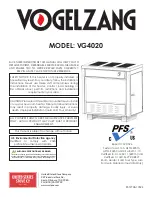
Page 41
Installation and Operation Manual - FW3200
ENGLISH
• Maximum overall length of horizontal pipe: 10 ft. (3 m) including elbows.
• Minimum clearance from combustible material: 18" (450 mm). The minimum clearance may be
reduced by 50 percent to 9" (225 mm) if suitable shielding is installed either on the pipe or on the
combustible surface.
• The assembly should be as short and direct as possible between the stove and chimney. The use
of two 45 degree elbows is often preferable to a single 90 degree elbow because less turbulence is
created in the exhaust flow and they result in less horizontal run.
• The minimum overall height of the chimney system, measured from the stove top to the exterior
termination cap of the chimney should be at least 12 ft. (3.66 m). A chimney which is too short may
lack the “tunnel effect” required to obtain a proper draft.
• Maximum number of 90-degree elbows: 2.
• Maximum unsupported horizontal length: 3 ft. (1 m).
• Galvanized flue pipes must not be used because the coatings vaporize at high temperatures and
release dangerous gases. Use black painted flue pipes.
• Flue pipes must be at least 24 gauge in thickness.
• Flue pipe joints should overlap 1 ¼" (30 mm).
• Each joint in the assembly must be fastened with at least three screws.
• The assembly must make allowance for expansion: elbows in assemblies allow for expansion;
straight assemblies should include an inspection wrap with one end unfastened, or a telescopic
section.
• Minimum upward slope towards the chimney: ¼ in/ft. (20 mm/m).
• One end of the assembly must be securely fastened to the flue collar with 3 sheet metal screws and
the other end securely fastened to the chimney.
• There must be provision for cleaning of the pipes, either through a clean out or by removal of the
pipe assembly. Removal of the assembly should not require that the stove be moved.
• The male ends of the sections must be oriented towards the appliance so that falling dust and
condensation stay inside the pipe.
• A flue pipe must never pass through a combustible floor or ceiling or through an attic, roof space,
closet or concealed space. Where passage through a wall or partition of combustible construction
is desired, the installation shall conform to CAN/CSA-B365, Installation Code for Solid-Fuel-Burning
Appliances and Equipment.
• A straight up connector assembly needs either a telescopic length or an inspection wrap (pipe
coupler) to allow it to be assembled and disassembled without moving the stove.
• A straight flue pipe assembly offers the least restriction to gas flow and results in a stronger draft.
Straight assemblies also need less maintenance because there are no corners to collect creosote.
• The chimney connector must be clean and in good condition.
Содержание CB00023
Страница 2: ......
Страница 6: ...Page 6 Installation and Operation Manual FW3200 ENGLISH CERTIFICATION PLATE ...
Страница 48: ...Page 48 Installation and Operation Manual FW3200 ENGLISH Appendix 6 MOBILE HOME INSTALLATION ...
Страница 54: ...NOTES ...
Страница 55: ...NOTES ...
















































